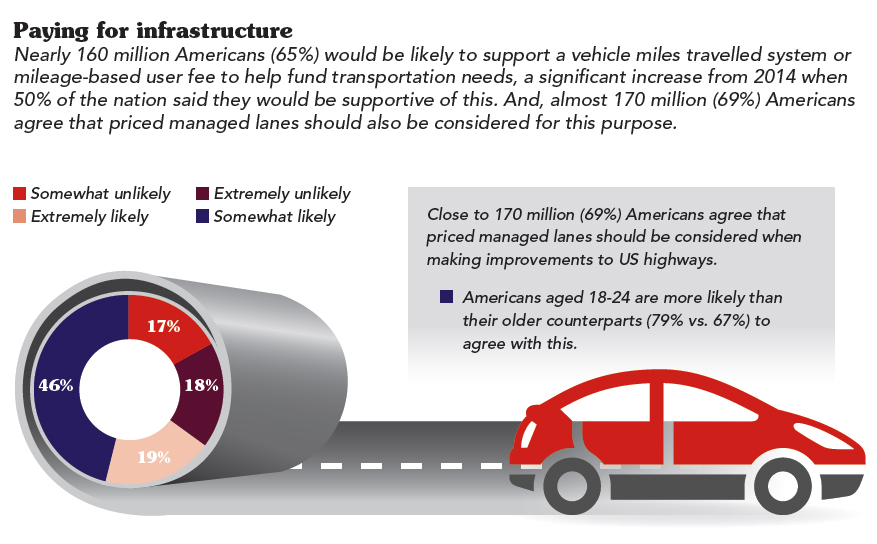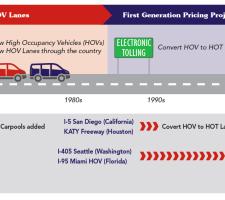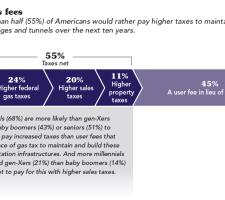
Infrastructure is the most neglected yet the most critical engine of our society, and our continued indifference could lead to a dystopian future. Our roads, bridges and highways have been largely passed by in the digital age—marginalised in an era when funding is limited and stewardship of physical assets has given way to our preoccupation with technological innovation and data—the stuff of the virtual realm.
Without sustainable funding our infrastructure faces an uncertain future and the impact on society will be tangible.
The current fuel tax is inadequate and economic and behavioural trends are forcing us to seek a better solution.
One compelling alternative is road pricing. We’re all familiar with pricing as congestion management; the concept of charging drivers a fee for a faster trip has proven effective time and again so it’s not difficult to envisage a user fee based on miles traveled as a principal revenue source.
Priced managed lanes are an embryonic version of mileage-based pricing—a logical first step to an inevitable conclusion. The evolution is underway. In Los Angeles, LA Metro converted high occupancy vehicle (HOV) lanes to high occupancy toll (HOT) lanes on sections of the 10 and 110 freeways, collecting a fee from non-exempt vehicles for the privilege of using the faster lane.
Other HOV lanes have been converted to HOT lanes in Atlanta, southeast Florida, northern Virginia, Minneapolis-St. Paul, Seattle and Houston.
Priced managed lanes are here to stay because there’s a direct correlation between the mechanism and the desired outcome: they improve overall mobility and help manage congestion at peak times. They generate revenue and help pay for road maintenance and reduce capital costs by maximising the use of the existing infrastructure and reducing the need to build more.
It’s a simple case of optimising lane utilisation and selling the spare capacity to drivers willing to pay for convenience and reliability.
The need for a sustainable funding source is ‘the elephant in the room’. The
An indispensable utility we all use multiple times every day deserves our full attention but has been marginalised over the years.
The Congressional Budget Office says public transportation spending has declined as a proportion of GDP since 1959. When infrastructure is neglected the impact is felt in a myriad of ways such as increased vehicle damage and operating costs and longer journey times. In addition the cost of repairing deteriorating facilities is higher than maintaining them in good condition and congestion is exacerbated by outdated design
Historical Perspective
The need to relieve traffic congestion led to the creation of the first managed lanes in the 1970s when a bus strike in Los Angeles led officials to open the El Monte Busway to carpools. In suburban Virginia, carpools were allowed on a busway when gas prices became unbearable.The history of the federal gas tax has been chequered as it was enacted in 1932 but did not actually fund roads until 1956 with the growth of the interstate highway system. It has not increased since 1993, hasn’t kept up with inflation for decades and much of the revenue is diverted to unrelated government programs and debt servicing.
A University of Minnesota study cites a number of deficiencies of the gas tax, including not accounting for inflation or rising fuel efficiency, and not paying for the full cost of building and maintaining local roads or addressing congestion.
With more fuel-efficient and electric vehicles on the road not only is less tax being collected, it has also invoked criticism that it’s unfair to owners of older vehicles and a burden on lower income drivers. Similar complaints have been raised about the inequity of using general revenue sources that spread the cost of maintaining roads across non-users as well as users. There are also viable arguments against a transition to mileage-based pricing, so the concerns of multiple stakeholders must be addressed.
Trial and Acceptance
A viable, long-term solution may be on the horizon in the form of mileage-based pricing. Several states are conducting pilot programmes and the federal government will soon award grants to more states to run their own tests. The Surface Transportation System Funding Alternatives programme, part of the FAST Act, has allocated grants totalling $95million in 50/50 federal matching funds over five years to states wishing to participate.
Oregon is piloting a mileage based pricing program called OreGo and California will launch a similar pilot programme this year. This makes perfect sense in states with shrinking gas tax revenue due to brisk sales of hybrid and electric vehicles.
Other states - such as Washington and Colorado - will be conducting similar pilot programs, which should offer key learnings for policy makers and transportation leaders. Right now, there’s no established right way. For example, the University of Minnesota Center for Transportation Studies has floated a two-pronged approach of ‘a mileage-based user fee to recover the fixed costs of transportation services and time-based user fee to pay for the additional capacity needed in peak times.’
In practice mileage-based pricing must start with a groundswell of local successes and develop into a national programme. The federal government will monitor state pilot programmes and should do what it can to enable those programmes to flourish, resulting in a transformation to a singular, national funding mechanism—or at least a multi-state mechanism that effectively replaces the gas tax and maintain the Highway Trust Fund’s long-term solvency.
Addressing the Critics
As with any sweeping policy change there will be trade-offs, and it’s imperative to enter this period with eyes wide open. The University of Minnesota estimates if user fees pay for the full social cost of travel then drivers would experience a four-fold increase in the direct user-paid costs of roads. However, the gains could outweigh the cost in the form of lower taxes as well as reduced healthcare and insurance costs and time lost due to congestion. The study says further impacts include reduced demand for travel, increased off-peak demand, shorter trips, denser development, more delivery shopping and telecommuting and more widespread use of alternative modes such as biking, walking and public transit.
There is already ample evidence that collecting fees from drivers demanding swifter travel is successful, but priced managed lanes have also taught that it takes political will and sponsorship, consistent communication and public acceptance to succeed. Notably, the argument that it’s unfair to lower incomes has credence. Asha Weinstein Agrawal of San Jose State University has detected trepidation among rural and low-income drivers who have to drive long distances. They could pay more than they do now at the pump and might have difficulty budgeting for a monthly highway-use payment.
There’s also the argument that eliminating the gas tax reduces the incentive to buy fuel-efficient cars and there are privacy concerns when it comes to data collection. California has addressed the privacy issue in its pilot program by offering participants a choice of how they report mileage - from paper diaries to in-car GPS systems.
Future Generations
This issue is as much behavioural as it is economic - if not more. Investing in and maintaining the nation’s infrastructure in a sustainable way requires not only accepting rapidly changing social trends but also a comprehensive assessment of public opinion.
A new America THINKS survey by HNTB reveals that 65% of Americans support road-usage fee options such as mileage-based user fees to help fund transportation costs. That’s a 15% increase in just two years, due largely to local governments rolling out tangible projects and more people experiencing them. Anyone who gets to a meeting on time or makes their flight thanks to a priced managed lane is more amenable to mileage-based pricing. Perhaps the most telling statistic is nearly four in five Americans (77%) aged between 18 and 24 are likely to support user fees, versus 63% of older Americans. This is the demographic of the future, the people who will be driving on the roads for decades to come.
Older Americans have a history with the interstate highway system and an expectation of free roads - a conviction not found in younger generations. Baby Boomers have a love affair with the automobile and the freedom it confers while Millennials are less romantic about transportation. They see trip making as using their smartphone. For them, technology is transportation; the smartphone gets them to their destination - whether it’s summoning an Uber or purchasing a train fare.
The case for mileage-based pricing is further validated by the inception of connected vehicle technology. The car of the future will operate itself while generating data on miles travelled and where travelled, making it easy and seamless to monitor usage and collect the fee. The connected vehicle will also help solve the ever-growing congestion problem in urban areas. Infrastructure will be able to accommodate more vehicles, thereby reducing or eliminating the need to build on to roadways.
Projects to date have provided lessons and offered some guiding principles for transportation officials, policymakers and engineers:
- Understand the community, project history, context and purpose
- Define success broadly; this is a programme not just a project
- Don’t under or overestimate the project benefits
- Focus on operations and consider the entire corridor
- The public’s willingness to pay may come as a surprise
But perhaps the biggest key to success is communication and never letting progress on the ground outpace the message. This means conducting outreach before, during and after construction because how an authority responds can build, or destroy, credibility. This is not a traditional type of project so people may not know what to expect.
A sea change in infrastructure funding starts with strategic visioning and leadership, followed by stakeholder engagement, advocacy and careful economic calculation. The seeds are only now being planted and it may take years to achieve a nationwide system of mileage-based pricing, but any historic pursuit of sweeping proportions is worth it.
- ABOUT THE AUTHOR: Matthew Click is vice president and national director of priced managed lanes at HNTB Corporation. He has more than 20 years’ experience of tolling, transportation policy and finance, including priced managed lanes, traffic and revenue forecasting, congestion pricing/road pricing and public-private partnerships. Over that time he has worked on road pricing, priced managed lane and tolling projects in more than 12 states for both the public and private sector.













